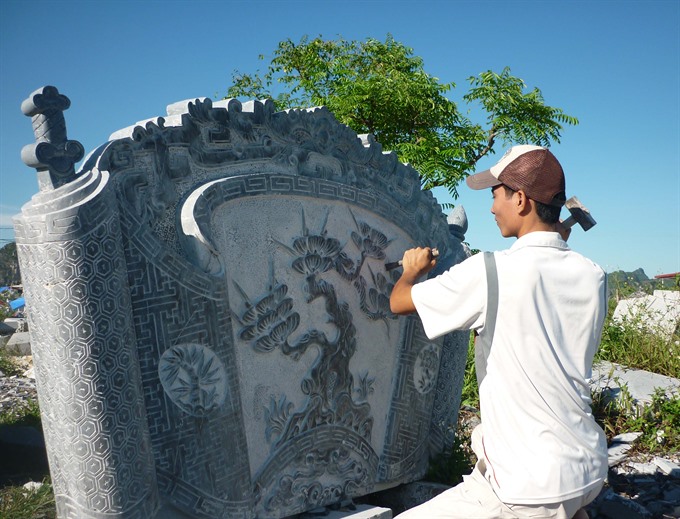 Life & Style
Life & Style

Đinh Thị Long has lived in her house in Ninh Vân village for over 50 years, and is still getting used to the idea that it has become a major tourist attraction in the famous stone carving village in northern Ninh Bình Province’s Hoa Lư district.
 |
| Ancient tradition: The stone welcome gate of the Ninh Vân stone carving village. — VNS Photo Bạch Liên |
Đinh Thị Long has lived in her house in Ninh Vân village for over 50 years, and is still getting used to the idea that it has become a major tourist attraction in the famous stone carving village in northern Ninh Bình Province’s Hoa Lư district.
The 100 year-old house, almost entirely built of natural blue stone, has attracted lots of tourists from Việt Nam and abroad who are interested in the art of stone carving of this ancient capital.
Besides the red tiled-roof, almost all other parts of the house and its furniture were built in stone: from its walls and pillars, to its gate and fences.
The house was built by her husband’s grandfather who was a talented stone carver.
“He was invited to build the stone Phát Diệm cathedral in Kim Sơn District of Ninh Bình Province. After he finished building the cathedral, he invited the group of stone carvers (who built the cathedral with him) to his village to help him build his house,” recalls the 77 year-old woman.
It took them two years to build the house.
Nguyễn Quang Diệu, who is head of the managing board of the stone carving village, says the house is unique in the region. “Many researchers and stone carvers have come here to study how the house was built,” he said.
 |
| Tourist attraction: The 100-year-old house owned by Madame Đinh Thị Long is almost entirely built of natural blue stone. — VNS Photo Bạch Liên |
The art of stone carving first appeared in Ninh Vân commune four centuries ago, a natural development given that Ninh Bình is surrounded by spectacular limestone mountains.
In the past, stone carving was only practiced in a few households in the commune, and they mainly produced items made of blue stone, which were sold locally.
But gradually many people began to benefit from this industry.
Diệu said that the village has known a wave of development in the past 20 years in light of an increasing demand for stone products nation-wide.
Almost 85 per cent of the commune’s working age inhabitants (about 3,000 inhabitants) take part in the carving industry. They produce stone carvings ranging from simple to sophisticated designs, most of which have become popular in many areas of the country.
The village’s diverse products are also exported to the US and Europe. These range from small ornamental plant pots, to large-scale Buddha statues, war martyr statues and even bridges.
 |
| Increasing demand: A craftsman in Ninh Vân carves in stone. — Photo ninhbinhtravel.net |
Nguyễn Văn Thịnh, 55, son of Madame Phong, said he learned the art when he was a small child.
“Since I was a child, I helped my father with his workd.We did it manually, and it was very hard. But I loved watching the beautiful objects that my family could create from huge stone blocks,” he recalls.
When he grew up, he opened his own stone carving enterprise. The work has become easier with the advent of machinery.
“To better understand how much our village’s stone carving is appreciated, you should come to see some well-known sites in my province. They include the stone Phát Diệm cathedral, the welcome gate at the Tam Cốc Bích Động tourism area, and the stone bridge leading to the Đinh and Lê King temples –where the kings of the Đinh and Lê dynasties are worshipped,” he said.
The popularity of the stone products is a source of pride to its residents. The village itself, located 2-hour drive from Hà Nội, is well worth a visit. — VNS




